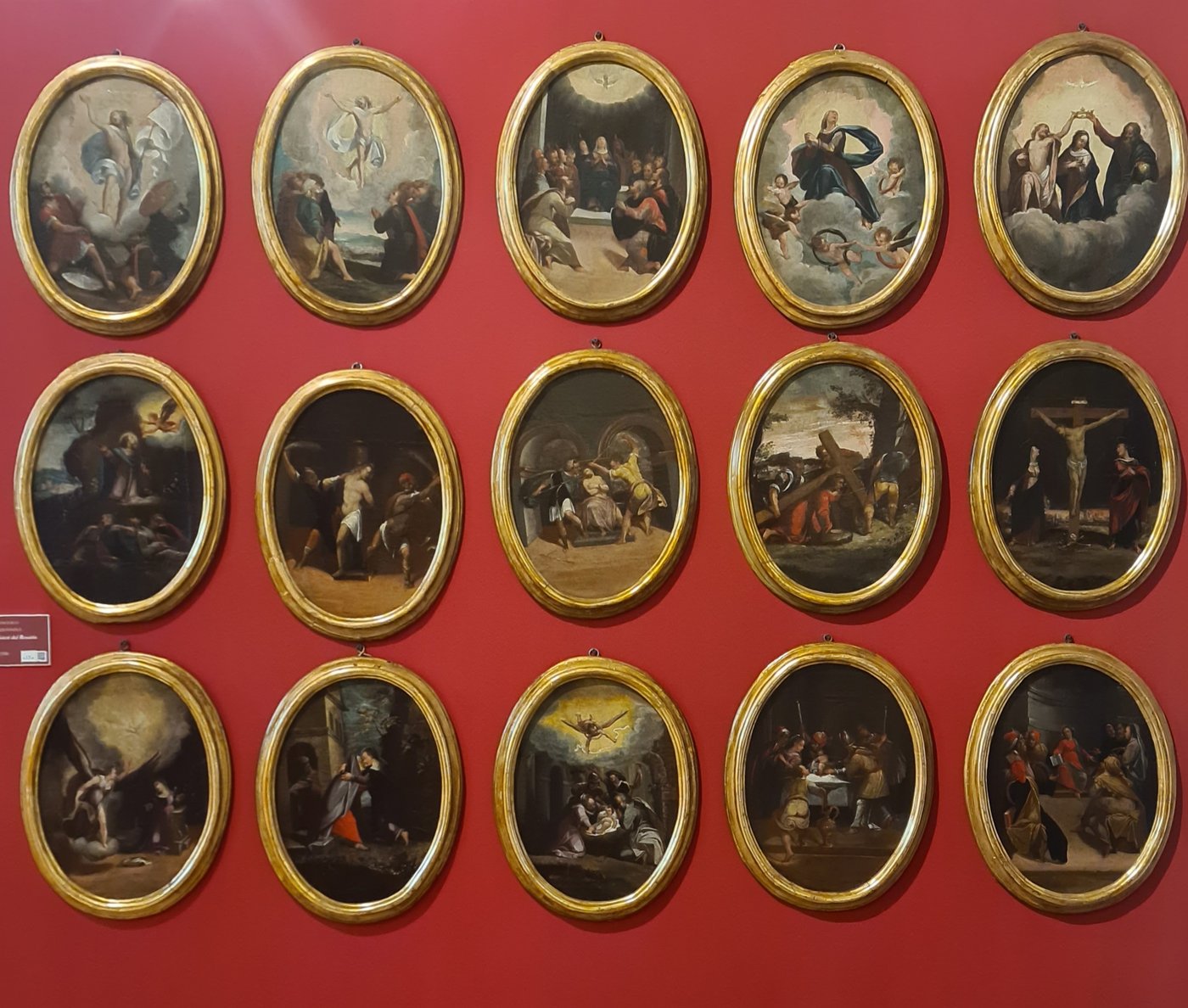QR code

FRANCESCO MADONNINA (notizie dal 1578 al 1589)
15 soggetti; olio su tela; c. 1590
Inv. 171. Dalla chiesa parrocchiale di Quingentole.
Seguendo uno schema diffuso, anche nella chiesa di Quingentole precedente l’attuale, le scenette attorniavano la pala dell’altare intitolato alla Madonna del Rosario; queste tuttavia si distinguono dalle numerose serie similari per vivacità cromatica e compositiva, indice di una notevole maturità d’espressione.
La popolare recita del rosario, pare codificata da San Domenico nel XIII secolo, si compone di preghiere intorno a quindici “misteri” che sono i fatti principali della vita di Gesù e di Maria. I fatti sono ripartiti in tre serie, disposte qui dal basso verso l’alto, con i rispettivi soggetti nell’ordine da sinistra.
Misteri gaudiosi: L’annunciazione / Maria visita Elisabetta / Nascita di Gesù / Gesù presentato al tempio / Gesù ritrovato tra i dottori del tempio.
Misteri dolorosi: Gesù prega nell’orto degli ulivi / E’ flagellato / E’ coronato di spine / Sale al calvario / E’ crocifisso.
Misteri gloriosi: Gesù risorge / Gesù sale al cielo / La Pentecoste / Maria è assunta in cielo / Maria è incoronata Regina.
Poichè il rosario prevede per ogni mistero la recita di dieci Ave Maria precedute dal Padre Nostro, il rosario completo è composto da centocinquanta Ave Maria, che popolarmente sostitutivano la preghiera della liturgia delle ore, che il clero recitava settimanalmente ed era composta da centocinquanta salmi.
Nell’anno 2002 il papa San Giovanni Paolo II ha aggiunto ai 15 misteri tradizionali i cinque Misteri della luce (o Misteri luminosi), relativi alla vita pubblica di Gesù prima della Passione. Nell’ordine: Il battesimo di Gesù al Giordano / Le nozze di Cana / La proclamazione del Regno di Dio / La Trasfigurazione / L’istituzione dell’ Eucaristia.
Mysteries of the Rosary
FRANCESCO MADONNINA (information from 1578 to 1589)
15 subjects; oil on canvas; c. 1590
Inv. 171. From the parish church of Quingentole.
Following a widespread pattern, also in the church of Quingentole that preceded the current one, the scenes surrounded the altarpiece dedicated to Our Lady of the Rosary; however, these stand out from the numerous similar series for their chromatic and compositional vivacity, indicative of a remarkable maturity of expression.
The popular recitation of the rosary, apparently codified by St Dominic in the 13th century, consists of prayers around fifteen “mysteries”, which are the main events in the lives of Jesus and Mary. The events are divided into three series, arranged here from bottom to top, with the respective subjects in order from left to right.
Joyful mysteries: The Annunciation / Mary visits Elizabeth / The Birth of Jesus / Jesus presented in the temple / Jesus found among the teachers in the temple.
Sorrowful mysteries: Jesus prays in the Garden of Olives / He is scourged / He is crowned with thorns / He ascends Calvary / He is crucified.
Glorious Mysteries: Jesus rises from the dead / Jesus ascends into heaven / Pentecost / Mary is assumed into heaven / Mary is crowned Queen.
Since the rosary requires the recitation of ten Hail Marys preceded by the Our Father for each mystery, the complete rosary consists of one hundred and fifty Hail Marys, which popularly replaced the Liturgy of the Hours, which the clergy recited weekly and consisted of one hundred and fifty psalms.
In 2002, Pope Saint John Paul II added the five Mysteries of Light (or Luminous Mysteries) to the 15 traditional mysteries, relating to the public life of Jesus before the Passion. In order: The Baptism of Jesus in the Jordan / The Wedding at Cana / The Proclamation of the Kingdom of God / The Transfiguration / The Institution of the Eucharist.



